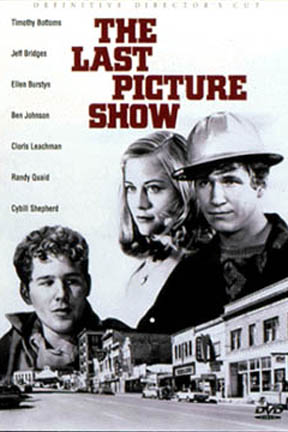Suddenly all the people who were swarming around Dennis Hopper are now swarming around Peter Bogdanovich, who can probably write his own ticket for the foreseeable future. The Last Picture Show is the the movie with the great New York reviews. Larry McMurtry seems to have collaborated rather smoothly with Bogdanovich. Almost everything in the movie is to be found in the novel. The same characters, the same names, basically the same relationships and situations. At first glance, the movie is a faithful and skillful adaptation of the source, but a second look at both the film and the book reveals some interesting divergences. At its best, McMurtry’s novel strains toward Women in Love. At its worst, it sinks into Winesburg, Ohio. What is fascinating about Bogdanovich’s treatment is that he avoids both the challenges of Lawrencian sensuality and the pitfalls of Andersonian pseudo-sensitivity. Jacy Farrow is the most fleshed-out of McMurtry’s characters, and not simply because she happens to be played by ex-cover girl Cybil Shepherd, a personal discovery of the director. The amusingly callow coquettishness of the Jacy Farrow character just happens to lend itself to Bogdanovich’s discreetly distanced style. Bogdanovich reminds me bit of Truffaut also in the gingerly protective way he guides Shepherd through her erotic exercises, a way reminiscent of Truffaut’s tender camera caress of Catherine Deneuve in Mississippi Mermaid. Thus even when Miss Shepherd is clumsy, notably in the swimming pool strip-tease sequence, she is beautifully clumsy. I may find Claire’s Knee more lucid and rigorous, Deep End more inventive and inspired, and McCabe and Mrs. Miller more audacious in its wrong-headed individuality, but no movie I have seen this year can match the spark that The Last Picture Show has set off in audiences. (R) ANDREW SARRIS
Dec. 9-11, 7 & 9:30 p.m., 2011




